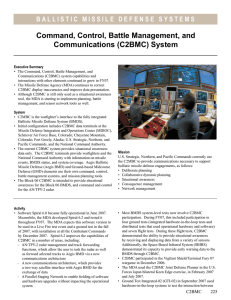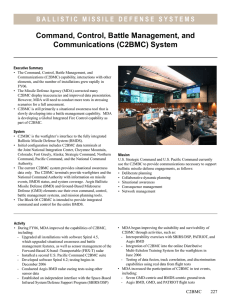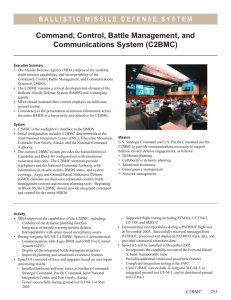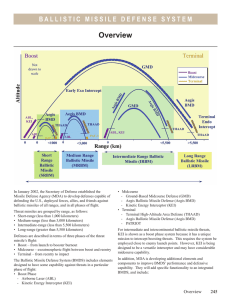Ballistic Missile Defense System (BMDS)
advertisement
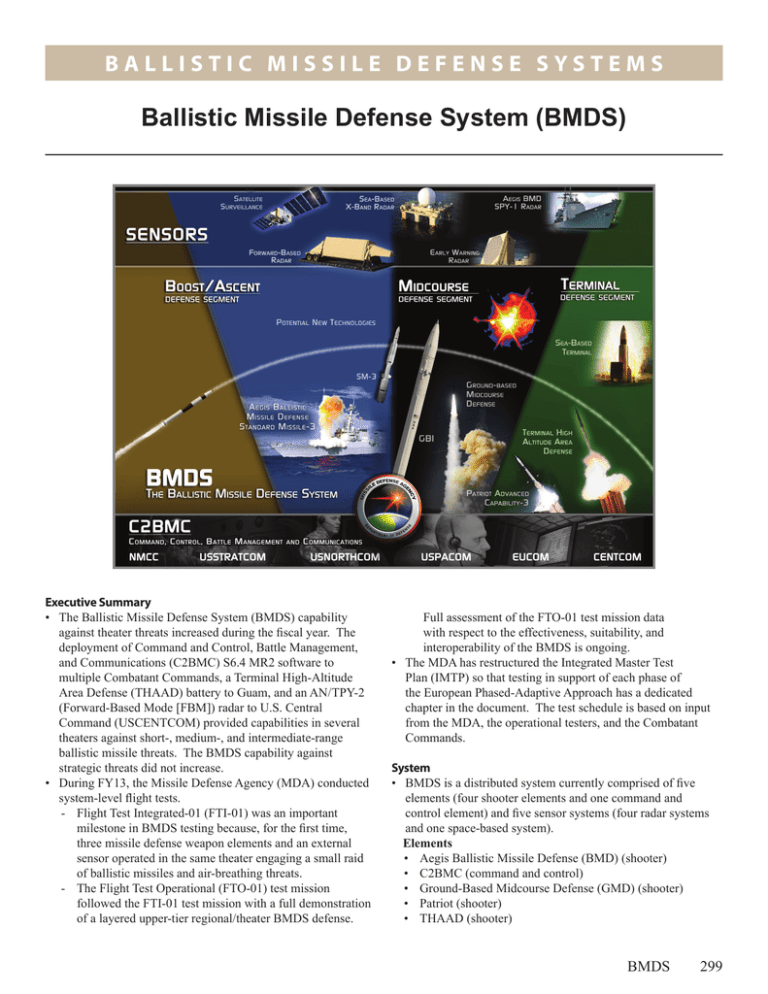
BALLISTIC MISSILE DEFENSE SYSTEMS Ballistic Missile Defense System (BMDS) Executive Summary • The Ballistic Missile Defense System (BMDS) capability against theater threats increased during the fiscal year. The deployment of Command and Control, Battle Management, and Communications (C2BMC) S6.4 MR2 software to multiple Combatant Commands, a Terminal High-Altitude Area Defense (THAAD) battery to Guam, and an AN/TPY-2 (Forward-Based Mode [FBM]) radar to U.S. Central Command (USCENTCOM) provided capabilities in several theaters against short-, medium-, and intermediate-range ballistic missile threats. The BMDS capability against strategic threats did not increase. • During FY13, the Missile Defense Agency (MDA) conducted system-level flight tests. - Flight Test Integrated-01 (FTI-01) was an important milestone in BMDS testing because, for the first time, three missile defense weapon elements and an external sensor operated in the same theater engaging a small raid of ballistic missiles and air-breathing threats. - The Flight Test Operational (FTO-01) test mission followed the FTI-01 test mission with a full demonstration of a layered upper-tier regional/theater BMDS defense. Full assessment of the FTO-01 test mission data with respect to the effectiveness, suitability, and interoperability of the BMDS is ongoing. • The MDA has restructured the Integrated Master Test Plan (IMTP) so that testing in support of each phase of the European Phased-Adaptive Approach has a dedicated chapter in the document. The test schedule is based on input from the MDA, the operational testers, and the Combatant Commands. System • BMDS is a distributed system currently comprised of five elements (four shooter elements and one command and control element) and five sensor systems (four radar systems and one space-based system). Elements • Aegis Ballistic Missile Defense (BMD) (shooter) • C2BMC (command and control) • Ground-Based Midcourse Defense (GMD) (shooter) • Patriot (shooter) • THAAD (shooter) BMDS 299 BALLISTIC MISSILE DEFENSE SYSTEMS Sensors • Aegis BMD AN/SPY-1 Radar • COBRA DANE Radar • Upgraded Early Warning Radars • AN/TPY-2 (FBM) Radar • Space-Based Infrared System/Defense Support Program (SBIRS/DSP) • Sea-Based X-band (SBX) Radar (primarily a test asset that can be operationally deployed as needed) USCENTCOM, and USPACOM also use the C2BMC to provide sensor management of theater AN/TPY-2 (FBM) radars across the full mission engagement space. • The Army employs Patriot to provide theater defense for deployed forces against short- and medium-range threats. Mission • The U.S. Strategic Command (USSTRATCOM) synchronizes operational-level global missile defense planning and operations support for the DoD. When directed, it provides alternate missile defense execution. • U.S. Northern Command (USNORTHCOM), U.S. Pacific Command (USPACOM), U.S. European Command (USEUCOM), and USCENTCOM employ the assets of the BMDS to defend U.S. territory, deployed forces, friends, and allies against ballistic missile threats of all ranges. Current capability permits limited defense of U.S. territory against simple ballistic missile threats and defending deployed forces, friends, and allies from theater-level ballistic missile threats. • USSTRATCOM, USNORTHCOM, USEUCOM, USCENTCOM, and USPACOM use the C2BMC element of the BMDS to maintain situational awareness. USEUCOM, Major Contractors • BMDS Integration: The Boeing Company, Network and Space Systems – Huntsville, Alabama • Aegis BMD and Aegis Ashore: Lockheed Martin Corporation, Mission Systems and Training – Moorestown, New Jersey • C2BMC: Lockheed Martin Corporation, Information Systems and Global Solutions – Gaithersburg, Maryland • GMD: The Boeing Company, Network and Space Systems – Huntsville, Alabama • Patriot: Raytheon Company, Integrated Defense Systems – Tewksbury, Massachusetts • THAAD: Lockheed Martin Corporation, Missile and Fire Control – Dallas, Texas • Sensors: Raytheon Company, Integrated Defense Systems – Tewksbury, Massachusetts; Lockheed Martin Corporation, Mission Systems and Training – Moorestown, New Jersey; Lockheed Martin Corporation, Space Systems – Sunnyvale, California; Northrop Grumman Corporation, Aerospace Systems – Redondo Beach, California Activity • The MDA conducted system-level flight testing during FY13 in accordance with the DOT&E-approved IMTP. System‑level ground testing is reported in the individual article on C2BMC later in this section. • The MDA conducted FTI-01 in October 2012, which included Aegis BMD and Patriot engagements of short-range ballistic missiles while defending against cruise missile attacks, and a THAAD first time engagement of a medium-range ballistic missile. The Aegis BMD and THAAD engagements were designed for near-simultaneous intercept. SBIRS/DSP provided early warning and an AN/TPY-2 (FBM) radar provided acquisition cues via C2BMC. Soldiers performed command and control functions from the Air and Space Operations Center at Hickam AFB, Hawaii. • The BMDS Operational Test Agency and the MDA conducted FTO-01 in September 2013. The FTO-01 test mission was designed to demonstrate a layered upper-tier regional/theater BMDS defense against a raid of two simultaneously-launched and threat-representative medium-range ballistic missiles threatening a shared defended area. The Aegis BMD element engaged the first target while the THAAD element engaged the second target and provided a secondary engagement capability against the first target. • The MDA, in collaboration with DOT&E, updated the FY12 version of the IMTP to incorporate BMDS element maturity, program modifications, and fiscal constraints. In parallel, the MDA continued efforts to align the IMTP with BMDS modeling and simulation verification, validation, and accreditation data requirements. • During FY13, the Lethality Focus Group continued collaboration to identify lethality data gaps for all BMDS weapon elements. Further, the Group began reviewing the performance of “first principles” physics-based software tools for potential use in predicting the lethality of BMDS intercepts. • During FY13, the MDA conducted numerous war games and exercises that enhanced Combatant Command BMD readiness and increased confidence in the deployed elements of the BMDS. • To support FTO-01 directly, plus future operational testing scheduled in the IMTP, the MDA completed approximately 80 improvement and modernization efforts at the Reagan Test Site (Kwajalein Atoll) and Wake Island. These efforts included power, water, and fuel infrastructure; lodging and office accommodations for system operators and flight test personnel; lightning protection for deployed test assets; instrumentation improvements and security facilities construction; test site upgrades to accommodate unique test support equipment; and installation of communications infrastructure to support increased mission data and voice networks. 300 BMDS BALLISTIC MISSILE DEFENSE SYSTEMS Assessment • Significant to a system-level characterization of BMDS, the MDA conducted the first integrated flight test that included Aegis BMD, Patriot, and THAAD, as well as C2BMC and an AN/TPY-2 (FBM). FTI-01 included basic system-level integration, but not layered defense. The weapon elements operated independently of one another, although they did exchange track data with each other and received cues from the AN/TPY-2 (FBM) radar via C2BMC. In spite of the test limitations, FTI-01 was an important milestone in BMDS testing because, for the first time, three missile defense weapon elements and an external sensor operated in the same theater engaging a small raid of ballistic missiles and air‑breathing threats. • The FTO-01 test mission demonstrated an integrated and layered upper-tier regional/theater BMDS defense. The initial assessment of data indicated that the simultaneous launch of the two medium-range ballistic missile targets occurred. The Aegis BMD intercepted one target and THAAD intercepted the other target while simultaneously engaging the debris from the Aegis BMD engagement. Full assessment of FTO-01 test mission data with respect to the effectiveness, suitability, and interoperability of the BMDS is ongoing. • The MDA implemented significant improvement for tracking modeling and simulation verification, validation, and accreditation completion over FY13. This tracking capability is the first step in adjusting the IMTP to better align with the overall modeling and simulation effort. The MDA developed a software tool, which correlates these key performance parameters, the BMDS mission threads, and the IMTP-approved test schedule. However, many of the models and simulations used in the ground tests remain with limited accreditation, which constrains performance assessment, thereby limiting quantitative assessments based on their results. • Although the Lethality Focus Group has developed a plan of action to address BMDS lethality data voids, the MDA has made little progress in retiring them. • The BMDS capability against theater threats increased during the fiscal year. The deployment of C2BMC S6.4 MR2 software to multiple Combatant Commands, a THAAD battery to Guam, and an AN/TPY-2 (FBM) radar to USCENTCOM provided capabilities in several theaters against short-, medium-, and intermediate-range ballistic missile threats. These capabilities were demonstrated through ground testing. During FTI-01, sensors and weapon systems worked together to engage five theater-level targets. Initial results show that the FTO-01 test mission also will contribute significantly to the system-level body of knowledge. • The BMDS capability against strategic threats has not increased. The GMD program experienced a flight test failure in Flight Test, Ground-Based Interceptor-07 (FTG-07) where the Capability Enhancement I Exoatmospheric Kill Vehicle failed to separate from the third stage booster. A Failure Review Board has been convened to address this failure. Recommendations • Status of Previous Recommendations. The MDA satisfied the outstanding FY08 and FY09 recommendations. Any remaining recommendations specific to the BMDS elements can be found in the reports for those programs (i.e., the recommendation to repeat flight tests to verify root causes and Failure Review Board results for Aegis BMD and GMD flight test failures). Additionally, the MDA still needs to continue addressing the interoperability and command and control deficiencies uncovered during the GT-04 test campaign and FTI-01. Resolution of these deficiencies should be demonstrated through ground and/or flight testing • FY13 Recommendations. None. BMDS 301 BALLISTIC MISSILE DEFENSE SYSTEMS 302
